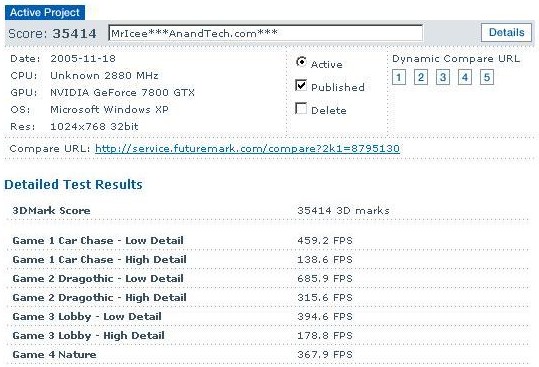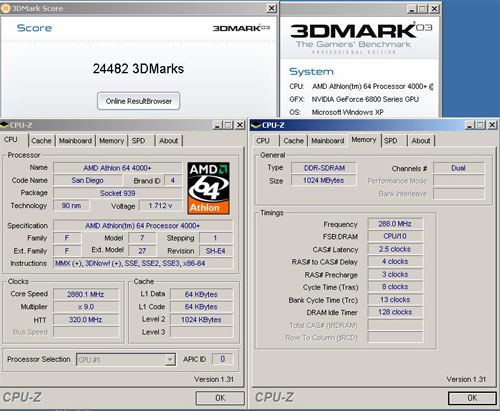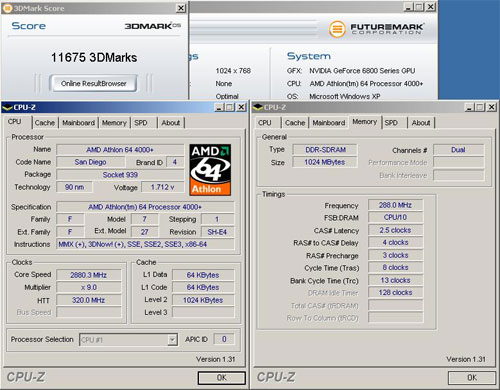DFI NF4 SLI-DR Expert – Can the best get better?
by Randi Sica on November 25, 2005 12:05 PM EST- Posted in
- Motherboards
DFI NFR SLI-DR Expert – Overclocked 3D benchmark performance + SLI verification
3DMark 2001 and Aquamark3
3DMark 2003
3DMark 2005
Our SLI verification tests again utilized the 4000+ San Diego. Comparison tests were done to determine what combination of memory and divider would consistently produce the highest scores. The highest stable and benchmark repeatable CPU speed was 2880Mhz. BH-5 modules at the 166 divider (261 MHz) were evaluated against TCCD modules at the 180 divider (288Mhz), and scores were consistently higher with the TCCD. 2x512MB Corsair 3200XL modules (2.96V) that were used along with a pair of NVIDIA 6800 Ultra’s.
3DMark 2001 and Aquamark3

3DMark 2003
3DMark 2005
Our SLI verification tests again utilized the 4000+ San Diego. Comparison tests were done to determine what combination of memory and divider would consistently produce the highest scores. The highest stable and benchmark repeatable CPU speed was 2880Mhz. BH-5 modules at the 166 divider (261 MHz) were evaluated against TCCD modules at the 180 divider (288Mhz), and scores were consistently higher with the TCCD. 2x512MB Corsair 3200XL modules (2.96V) that were used along with a pair of NVIDIA 6800 Ultra’s.













40 Comments
View All Comments
nvidia4ever1 - Friday, November 25, 2005 - link
Let's add the following-Watercooling on the standard overclocking results??? I can see it on the extreme overclocking results but how many people watercool their systems in general and why not show air cooling. All other AT reviews are based on air-cooling, why the change now.
The gaming and general performance charts just do not make sense without comparing apples to apples. The 3Dmark chart is most confusing. Why not show some real game benchmarks, who freaking plays aquamark and pcmark?
Workstation performance??? WTF??? It was nice to see the AMD system romp on the Intel systems but if this board is for the extreme overclocker why do they care about Maya results?
Why compare 7800GTX results to 6800u results with different drivers? WTF is going on with this kind of testing.
Even though the audio/disk/ethernet performance should be the same, why not test it and see if something is different just in case. Considering the additional audio information in the last AMd and Intel board reviews, why not have it here with real games. Who knows, the cpu utilization could be a lot lower than other ALC850s (like Abit)or higher like Gigabyte.
Any reason not to mention how many and what the results were? Did Corsair or others have input into the testing like OCZ did? What kind of memory should I buy for this board?
It was good to see the overclocking information and what can be done with a board but why not show some real results with it. Can I play BF2 or COD2 at 320HTT? Please follow up with some game benchmarks at both standard and overclocked settings.
Wesley Fink - Friday, November 25, 2005 - link
Randi's earlier review followed standard AnandTech motherboard testing, but we asked him on this review to go wherever he wanted in overclocking on this Expert board. We had already tested the original DFI nF4 SLI-DR, and the Expert was primarily an upgreade to provide even better overclocking performance and stability at high overclocked speeeds.This seemed the perfect board to approach from an extreme overclocker's perspective - and that's exactly what Randi did. We decided a lot of water-cooling users would be interested in this board, so Randi used watercooling in some of his tests. He also included base performance numbers so you can compare to other AT reviews.
We have limited our standard reviews to air cooled overclocking, since that is very widely used these days (often by users who don't have a clue what they're doing). However, Gary, myself, and in particular Randi are all long-term overclockers, and sometimes we like to share a little more about where you can go with some of the equipment we test.
Consider this an extreme overclocker's review of an updated board clearly aimed at the extreme overclocker.
RSica - Friday, November 25, 2005 - link
"Any reason not to mention how many and what the results were? Did Corsair or others have input into the testing like OCZ did? What kind of memory should I buy for this board?"All the memory tested in the review was listed or mentioned(BH-5 based Kingston KHX3500 + OCZ Platiminum LE PC3500). The Kingston and OCZ BH-5 did not perform well on this board though the Corsair 3200LL BH-5 did and was included.The main reason for their poor performance could be attributed their age(2+ years old) and the fact I've pushed 3.6v+ through them in overclocking endeavors in the past.
OCZ did NOT have input into my memory testing, but their Guru Tony Leach provided some insight into the boards revisions as conveyed to him by DFI.
All results were listed as per the tables provided to illustrate top memory clocks for each of the Memory module sets.
Again, thanks :)
Randi
RSica - Friday, November 25, 2005 - link
As explained in my previous reply, I arrived here to review bringing with me an extensive overclocking background.The addition of watercooling brings a new dimension to the testing and evaluation performed in my reviews for AnandTech. There are many more people watercooling these days and its safe to to say that it is becoming more mainstream than even a couple of years ago.Of course when running a CPU at stock speeds in a review there is no benefit(outside of lower CPU temperature), the benefit only coming when attaining a top CPU overclock.I also have several Phase Change coolers that someday may be used for the Top Overclock
section which could include Top Overclock on air, water and or Phase Change. Just a thought for now:)
As mentioned before, I did update the Gaming Performance charts and will update the others as time allows.
As far as Workstation performance, though this board is aimed at the Overclocking crowd, with it's full feature set it indeed can fulfill a Workstation role and does so admirably IMHO.
Again, thank you for your comments,
Randi
Griswold - Friday, November 25, 2005 - link
I love my Ultra-D but 2 things I cant stand:1. The name "Lanparty"
2. The ridiculous childish box
ceefka - Friday, November 25, 2005 - link
Yeah that kid doesn't seem to grow up with you ;-)Barbarossa - Friday, November 25, 2005 - link
I believe the Corsair CMX1024-4000PT modules use the Samsung UCCC modules, not the Samsung TCCD modules. This would explain why they do not work at 2-2-2-5 latency.Also, TCCD ICs do not come in 64x8 density, so it's impossible to make a 1GB TCCD module without somehow cramming 32 chips on there.
Live - Friday, November 25, 2005 - link
I beleive this is correct. If not this would be the worlds first 1gb stick with TCCD.Calin - Friday, November 25, 2005 - link
"With the SIL 3132 available, it would have made sense to include that SATAII controller, which would have given this board 8 SATAII channels and thus keeping this board future-proof and flexible."How is a board with eight SATA connectors more future-proof than one with only 4 SATA connectors? Would anyone have more than 4 disk devices (hard drive, optical drive)?
Anyway, there are other four SATA ports from the chipset, so if you think they are lower performance, use them for SATA optical devices (when they will appear), and use the four connectors from the Sil controller to drive four hard drives.
MarkHark - Friday, November 25, 2005 - link
More important than the number of available ports is features. What about NCQ support? Is the current controller fully SATA-II compatible?